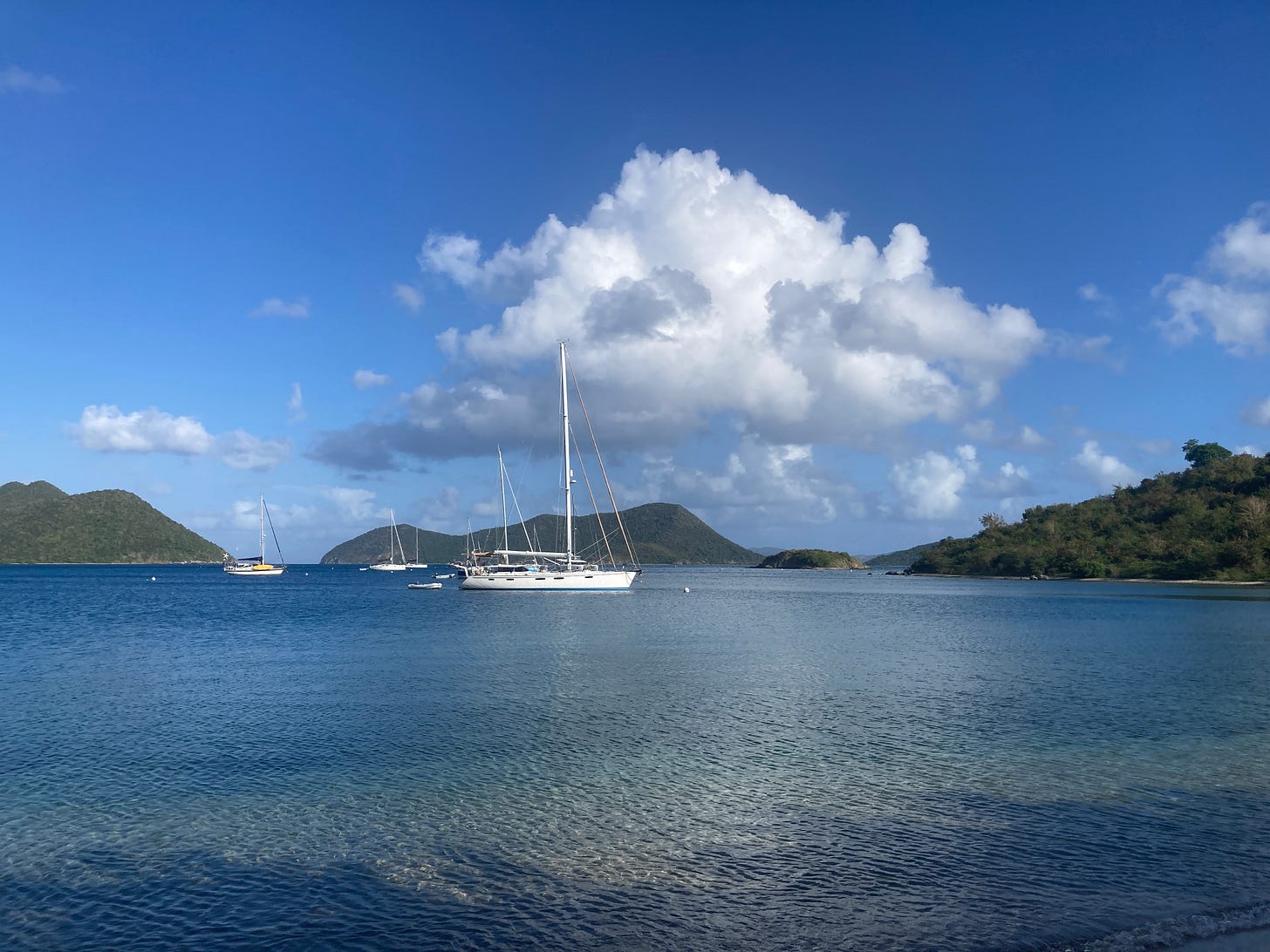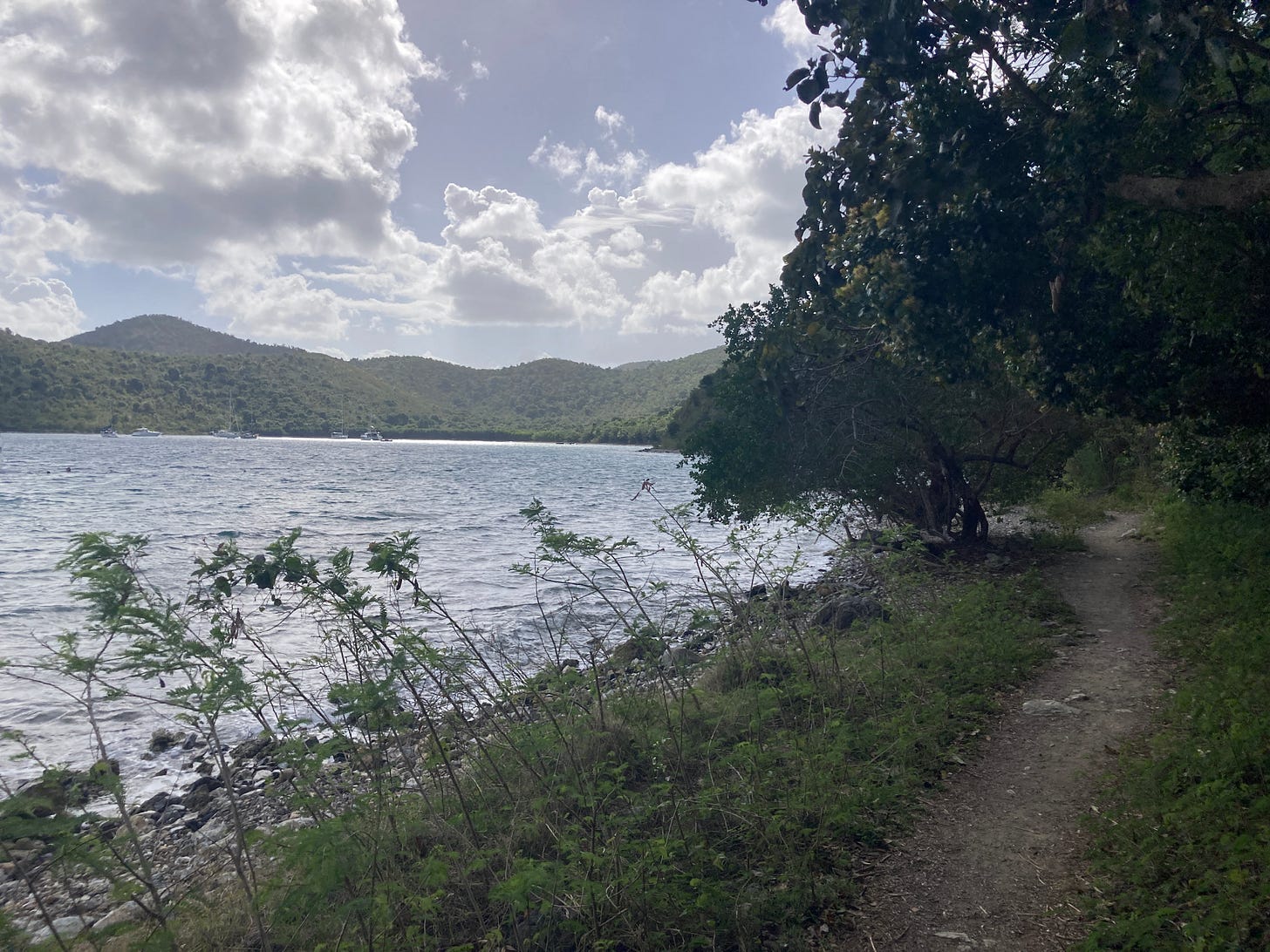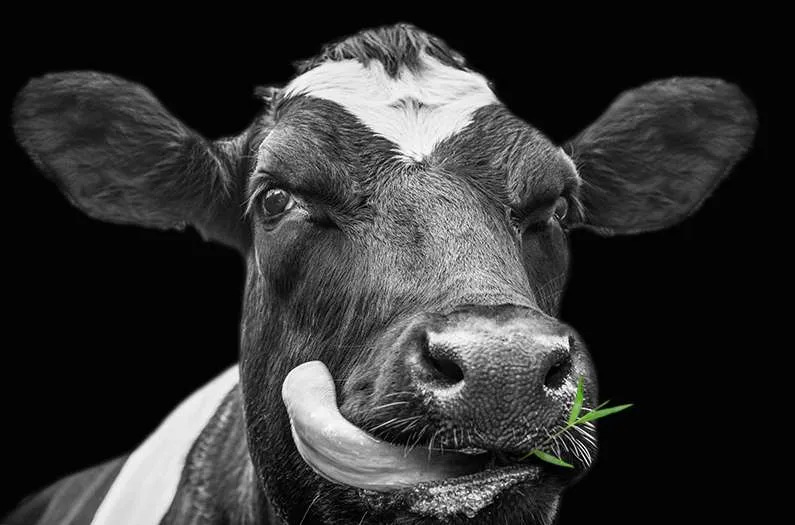Laughing Gull is swinging on a National Park Service mooring, and looking yar, in one of my favorite spots: Waterlemon Cay on St. John. This state of affairs follows an excellent and enjoyable week up in the unfrozen but still too chilly North. It is a pleasure to be be back in my preferred winter outfit: bare feet, shorts, t-shirt (actually, t-shirt is optional). It’s always energizing to take a little land break, spend time with the people you love, and sleep under a roof and without an anchor alarm.
I had a nice couple of days in DC, which included seeing my daughter, and then my wife and I road-tripped in her Electric Vehicle up to mostly still-frozen upstate New York to visit our son. Charging infrastructure in the United States has a long way to go, but there is something magical about being in a car for which gas stations, and maintenance, are largely irrelevant.
A bonus of that trip was seeing my son’s band, Lucky Strike, play live. Way cheaper to watch him perform “Knocking On Heaven’s Door” than going to see Dead & Co at Sphere in Las Vegas. Who played it better? John Mayer or Lucky Strike? Well, you can guess my biased answer. Though my son perhaps should credit John Mayer for some of his guitar-playing facial expressions.
While I was ashore, LG was stashed at Nanny Cay Marina on Tortola, getting some touch-ups. I arrived back aboard with a raging cold (one penalty of trading solitude for multitudes), and slept for 10 hours. I spent a day at the dock, re-provisioned, and then hightailed it from Nanny Cay. Marinas are useful, and inevitable at times. But I struggle to understand why anyone on a boat would want to spend long stretches tied up.
Achy, feverish, and with my nose gushing staggering volumes of effluent, I only wanted to get to a calm, well-protected, anchorage, where I could recuperate and restore my humanity. That is not easy to find in the BVI. Waterlemon Cay was the obvious choice, so here I sit on the mooring closest to the beach. It is pretty. It is not very crowded. I can trail run. And Coral Bay, which has provisions and bars, is but a 45-minute hike over a mountain. It is the perfect place to rusticate, resume some projects, and chill until my next guest arrives in April.
I woke up feeling almost myself this morning, and sat with a cup of coffee in the cockpit to watch an orange dawn break over the green hills protecting the bay. A turtle poked its head above water and stared at me for a moment before ducking under again. The water surface was active as bigger fish chased schools of smaller fish around LG. Pelicans wheeled overhead looking to get in on some of that small fish action (it’s tough to be a small fish). After coffee, I paddled my SUP ashore and ran the trail that connects Waterlemon Cay to Francis Bay. That’s what I call a good morning.
A big high pressure system over Bermuda is pumping the tradewinds up, and they should keep whistling throughout the coming week. That will keep LG cool and well-ventilated. Yet Waterlemon barely has any chop. The peace I feel here is in sharp contrast to the go-go charter busyness of the British Virgin Islands. I did manage to find one nice anchorage in the BVI before taking LG into Nanny Cay—a sweet little spot behind Buck Island on Tortola’s eastern end. It was well protected, and had a nice sandy bottom for good holding. Miracle of miracles, I was the only boat there overnight. I felt so lucky to have found it I wanted to go play the lottery the following morning.
I had been thinking to go to Little Harbour on Peter Island, for a nostalgia tour, as that is where I spent many a Christmas growing up (talk about lucky). But it is not a great anchorage: quite deep, a bit exposed, and subject to swirling winds. If too many charter boats were there I knew I would regret my choice. So I scanned Don Street’s Cruising Guide and Buck Island popped for me. “Why no one ever anchors behind Buck Island is beyond me,” Don wrote. “Why, indeed, Don?”I muttered, and headed in to find a peaceful and serendipitous spot to hole up for a night. Buck Island does have an exclusive resort, but it is so exclusive there is almost no one there, so it barely registered. Flat water, nice breeze, lots of stars, and mostly quiet (apart from planes on final approach to Beef Island overhead). A rare experience in the charter capital of the world.
The truth is that St. John and the BVI are two different Virgins in two different universes. The BVI is an entertainment park for charter boat sailors, with crowds, bars, water toys, and manufactured entertainment everywhere you go. St. John is mostly a national park, in which pristine waters and abundant sea life are the entertainment. It is an experience of immersion in natural beauty. The BVI is a an experience based on human-manufactured entertainment, a glorified theme park that occasionally gets pruned back by hurricanes, built on a platform of natural beauty. That is very different, and one that keeps legions of weeklong charter guests well-lubricated and very happy. For me, though, it is too much, and has evolved over the decades since I first came here into economic overexploitation of a beautiful landscape.
Still, I can’t really second-guess the BVI for leaning into a strategy that brings a lot of much-needed revenue to the local government and people. It is part of a distinctive dynamic around the globe—one which is especially obvious to people cruising sailboats—in which, more and more, local economies in the most beautiful places in the world are pursuing the one strategy that seems most promising to them: which is to turn whatever beauty, resources, and hospitality they can muster into yet another sublime and Instagram-worthy travel or vacation experience for the very wealthy.
That is a logical consequence of global wealth disparities, but I find the unequal power dynamics and despoiling of natural beauty and wildlife to create playgrounds for the rich, disquieting.
Throw in the fact that these places often happen to be the places most vulnerable to climate change, and that it is the lifestyle of all these wealthy visitors, and the jet flights they are taking to vacate in every beautiful corner of the planet, that is accelerating the impacts of climate change, and you have a trajectory which isn’t very promising for the long term. There are better ways to achieve liveable incomes and economic security for global populations, ways that don’t require relentless extraction and exploitation of precious natural resources. In fact, here’s a very good one—a guaranteed universal basic income:
Sure, it’s a utopian idea, and would require a massive redistribution of wealth from one part of the globe to another. But I am nothing if not a utopian (and there is sufficient global wealth to achieve it). The modern world humanity has made, and continues to make, is deeply flawed, and on a destructive and dangerous course—the rise of right wing nationalism in response to migrants fleeing poverty, instability, and climate change is just one sign of this. It makes sense to define a way better place to voyage to, even if it seems a very long way away and will take time, and a global movement, to get there.
In the meantime, I will continue to hole up in my own private utopia at Waterlemon Cay. Winter is fading, and Spring is settling in. Boats in the Caribbean are on the move, with many headed back north. My mind has now turned to safely getting Laughing Gull across the Atlantic. We could go tomorrow, but there are always things to improve or work on while waiting for the active Spring weather along the route to Bermuda—my first stop—to settle down. Still, after a winter season of short hops, I’m well ready for longer voyages.
Anthropocene Notes:
There is a lot of beauty and drama in this short video. I hope to sail in this area next year.
Lifestyle Reminder #1 (sorry!): “Sustainable Fishing Is A Lie.” A very well done deconstruction of fishing certifications.
Three thousand feet under the sea, a mother orange roughy sheds her very first eggs above an ancient soft coral garden. She is 73 years in age. These fish are exceptionally slow to mature, but she may live for centuries—the rare black corals she swims among live for millenia. Suddenly, a titanic trawl net comes tearing across the seamount, scattering her delicate eggs into the frigid current. She swims for her life, but the net’s mouth is wider than the wings of a passenger jet. She is crushed against the bodies of her entire school. Her organs explode from rapid pressure change as fishermen drag her to the surface, at which point she is dismembered, freeze-wrapped in plastic packaging, and stamped as “sustainable seafood.”
Worst of all is industrial fishing. Now you know.
3. Lifestyle Reminder #2 (again, sorry!): Grassfed Beef Is Not Climate Friendly.
The finding of a new paper in PNAS may ruffle the feathers of some consumers and those in the cattle industry who believe that grass-fed beef is less carbon intensive than industrially-farmed cows. Their claim arises from the idea that the grasslands on which cows graze lock in tons of CO2, which offsets the climate impacts of notoriously emissions-intensive cattle.
But when Gidon Eshel, a research professor of environmental physics at Bard College and lead author on the new PNAS study quantitatively tested this claim, he and his colleagues came up with some stark numbers…
Per kilo of protein, the analysis revealed, even the most efficiently-generated grass-fed beef produces between 10 and 25% more emissions than industrial beef in the US. When the researchers then incorporated the benefits of soil carbon sequestration into the equation, it did shrink this footprint—but not enough to make grass-fed any better than industrial beef. In fact this greener grass-fed beef still produces between 180 and 290 kg CO 2eq per kilo of protein, which is on balance more than the 180 to 220 kg CO2eq generated per kilo of industrial beef. Overall, the researchers found that emissions from industrially-farmed beef were lower than emissions in 90% of cases in their simulations of grass-fed beef.
Beef is bad for the climate, people. There is no way around it.
If you liked this post from Sailing Into The Anthropocene, why not subscribe here (free!), and/or hit that share button below? You can also find me on Instagram and BlueSky.








